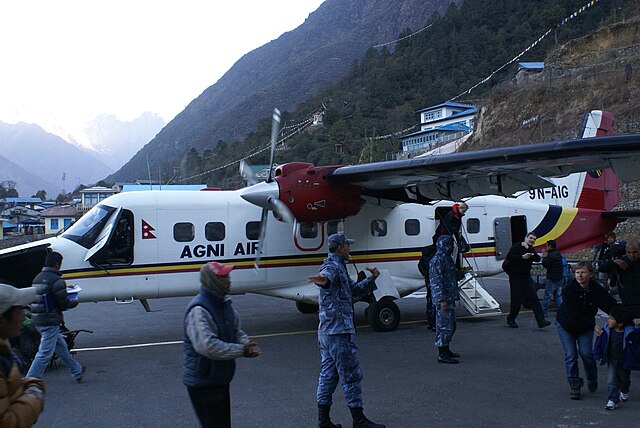
Photo: Moralist|Wikimedia Commons
Carriers such as Gorkha Airlines and Agni Air once operated in Nepalese skies but had to shut down due to various challenges, including the country’s unpredictable weather patterns, particularly in mountainous regions, which pose significant risks for flight operations. Airports like Lukla have experienced numerous crashes and have even been labeled “the most dangerous airport in the world.”
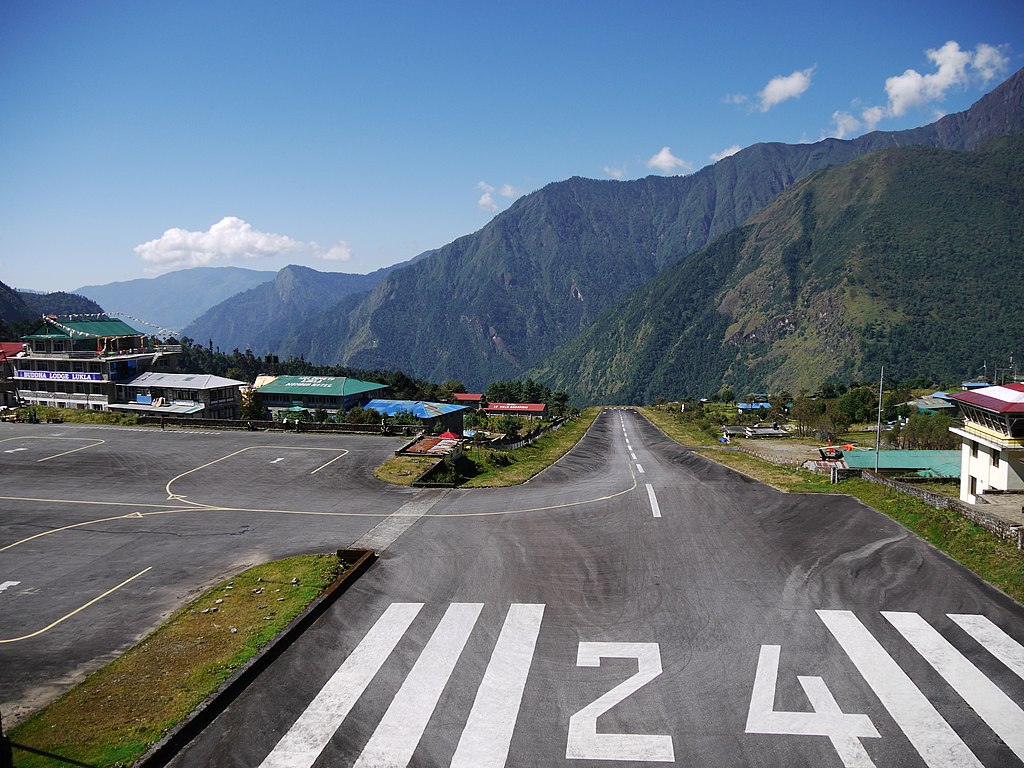
Photo: Smallufo|Wikimedia Commons
Airports like Lukla/ Tenzing-Hillary Airport, known for their dangerous landing conditions, require specialized aircraft and experienced pilots, further complicating operations; these are natural challenges in this nation. Another factor that doesn’t help the development of aviation in this nation is corruption, which is at a high-level. Nepal ranks 108 positions out of 180 countries in corruption. Nepal was mired in its biggest aviation scandal also known as “the wide body scandal” of more than a billion rupees.

Photo: Hariram sigdel h|Wikimedia Common
Airports like Pokhara and Gautam Buddha International Airport came with high hopes and potential to enhance connectivity and tourism, and improve Nepalese aviation. Pokhara Airport cost a total of $305million. With this huge investment, Pokhara Airport was expected to handle 1 million passengers in a year but only seven international flights have taken place so far. The Airport profit in the 2076/77 fiscal year is 35,569,027.49.

Photo:Santoshgurung1982|Wikimedia Commons
Gautam Buddha International Airport’s total construction cost is US $76.1 million. The airport has a target to collect Rs 89.15 million in revenue for the current fiscal year, but the office has collected only Rs 8.5 million in the last 10 months of the current fiscal year.
The reason behind both airports not doing well is that airlines face significant expenses when operating flights to these airports, which can discourage them from establishing routes. Low passenger demand means that both airports are experiencing low traffic, making it economically expensive for airlines to operate regular international flights
Despite these problems, Buddha Air and Yeti Airlines, alongside others, strive to navigate the complexities of operating in this challenging environment, like the most dangerous Airport in the world, Lukla. The airline company of Nepal schedules more than 50 flights in Lukla in a day during the peak trekking and climbing seasons.
Buddha Air
Buddha Air, whose name derives from “Buddha”, the peace emblem of Nepal, is the biggest airline in Nepal. It has 18 aircraft in its fleet – a combination of two ATR42s and sixteen ATR72 aircraft. This airline does not operate in the mountain region (STOL airports) of Nepal, and this is one of the contributory reasons why it has some of the best safety records in the nation. Buddha Air is currently operating to 14 destinations across the country and also offers flights to Banaras, India.
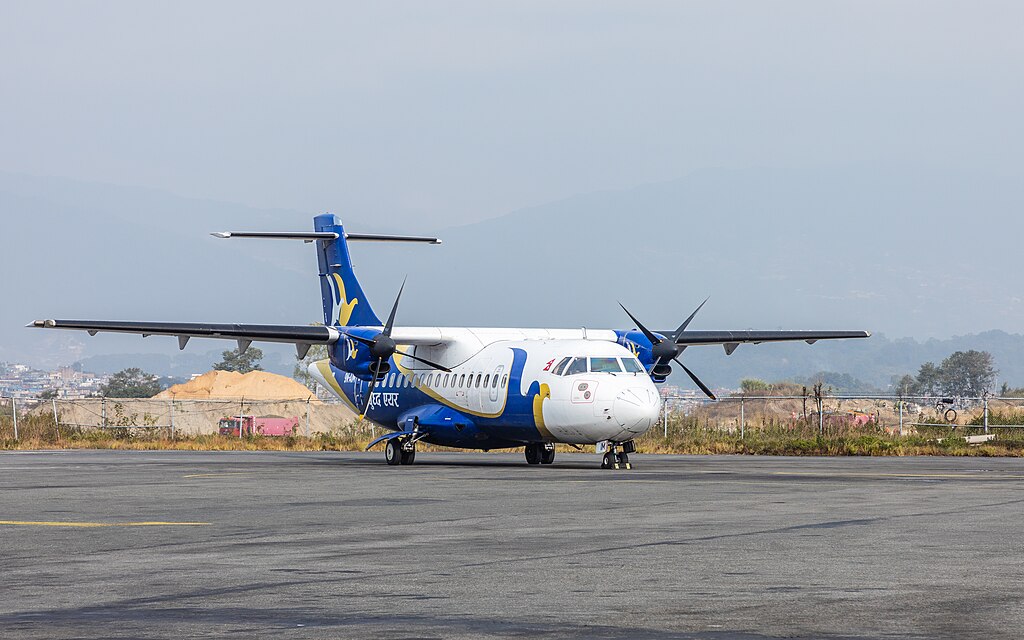
Photo: BijayChaurasia| Wikimedia Commons
The oldest aircraft of Buddha Air is ATR42 registered as 9N-AIM. This aircraft is also known as an active flight in Asia; this aircraft has 57,590 logged flight cycles. There are two other aircraft that have completed more than 50,000 flight cycles. The ATR42 registered as 9N-AIN has completed 57,439 flight cycles and the other ATR 72, registered as 9N-AJX has completed 53,371 flight cycles. Only five aircraft operated by Buddha are more than 20 years old.
Let’s look at some of the accidents/ incidents suffered by Buddha Air.
| Date | Number of casualties | Reason behind accident |
| 2011 September | 19 | According to aviation safety network this is Everest Experience’ sightseeing flight
No available literature on the subject on the internet |
| Jul 12th 2024 | There are 55 passengers and 4 crew were injured | Local police reported the aircraft became stuck in the mud |
| 16 December 2021 | 19 passengers | An emergency landing in Bharatpur on Thursday after one of its engines failed |

Photo: Paul Spijkers| Wikimedia Commons
Buddha Air’s logo features flying birds, which reminds one of the airlines helping people fly safely from one place to another. The airline wants everyone to feel free, like a bird in the sky.
Let’s have a look at what Buddha Air offers you in the mountain region:
- 50-minute flight consisting of a Panorama view of Mount Everest, just 20 miles from our window seat.
- The flight started at 8:00 AM early in the morning.We can witness the fantastic 20 of the highest peaks to the East of Nepal Himalayan peaks, lakes, and glaciers.
- With a 30-minute flight, you witness fantastic Himalayan peaks, lakes, and glaciers of various peaks of Pokhara.
- The Annapurna Experience mountain flight flies over the top peaks of Pokhara.
- Flight starts at 6:00 AM – 8:00 AM early in the morning.
- The flights are only available in the morning because at that time aircraft can face different kinds of weather conditions in mountain regions.
Yeti Airlines
Yeti Airlines was established in May 1998 after some months in August 1998 received its Air Operators Certificate. Yeti refers to the ape-like creature purported to inhabit the Himalayan region in Asia. Yeti started its journey with a Canadian-built DHC6-300 Twin Otter aircraft. In 2009 Yeti Airlines introduced its sister Tara Air for the STOL airport and the mountain region in Nepal. Tara Air operates DHC-6 Twin Otters.

Photo: PrakashAdhikari| Wikimedia Commons
Yeti Airlines has a total of 24 aircraft in its fleet history half of them are written off and stored because of an accident, some of the aircraft are sold to other airline companies and four aircraft are with Tara Air, there are seven aircraft in the current fleet. According to the planespotters.net, they currently operate ATR 42/72s, but they had four different types of aircraft in the past:
- British Aerospace Jetstream 41
- De Havilland Canada DHC-6 Twin Otter
- Embraer EMB-120 Brasília
- Saab 340
Let’s look at some of the accidents/ incidents suffered by Yeti and Tara air
| Date | Number of casualties | Reason behind accident |
| 21 June 2006 | 9 | Insufficient monitoring of its flight training program and line operations by Yeti management |
| 15 January 2023 | 72 | The inadvertent movement of both condition levers to the feathered position in flight which resulted feathering of both propellers and subsequent loss of thrust, |
| 29 May 2022, | 22 | The flight crew’s failure to monitor and maintain the proper course while inadvertently flying in IMC conditions with the aircraft [TAWS] inhibited which resulted in an accident. |

Photo:calflier001|Wikimedia Common
Despite these dangerous accidents Yeti Airlines has made a comeback and achieved the ISSA (IATA Standard Safety Assessment) certification for international safety standards, after the CEO of Yeti Airlines spoke some words.
“This achievement reflects the hard work and dedication of our entire team, as well as our commitment to providing our passengers with the safest and most reliable air travel experience.”
This award is given after evaluating the airline operator’s safety management system.
The first airline of Nepal to become a carbon-neutral airline.
Yeti Airlines became the first airline in Nepal, and most probably South Asia, to successfully reduce and offset its total Greenhouse Gas. UNDP congratulated Yeti Airlines on becoming the first carbon-neutral airline in Nepal after having successfully met the international UN approach to carbon neutrality. This was also one step forward to helping Nepal fulfill its commitment to the Paris Agreement on Climate Change.
Here are some reasons why Yeti achieved this milestone:
- Yeti Airlines produced 19,665 tones of CO2 equivalent emissions in 2018
- Yeti Airline was able to reduce the CO2 equivalent emissions per flight km by 20% in 2017 and 2018
- Yeti Airlines undertook various environmental and social projects such as the Yeti Green Reforestation Project, Green Far West Project, and the Everest Clean Up campaign.
Let’s have a look at what Umesh Chandra Rai, chief of Yeti Airline said after this achievement.
“We have pledged to demonstrate our leadership in aligning and supporting the Sustainable Development Goals (SDGs) in every opportunity, particularly promoting SDGs no. 5 Gender Equality, no. 13 Climate Action and no 17 Partnership for the Goals. Yeti Airlines is committed to remain carbon neutral and invites others to join hands to protect our environment for the future generations to come. To keep its promise of remaining carbon neutral, Yeti Airlines is further committed to work together with UNDP on community level climate adaptation initiatives in the future.”
Tara Air
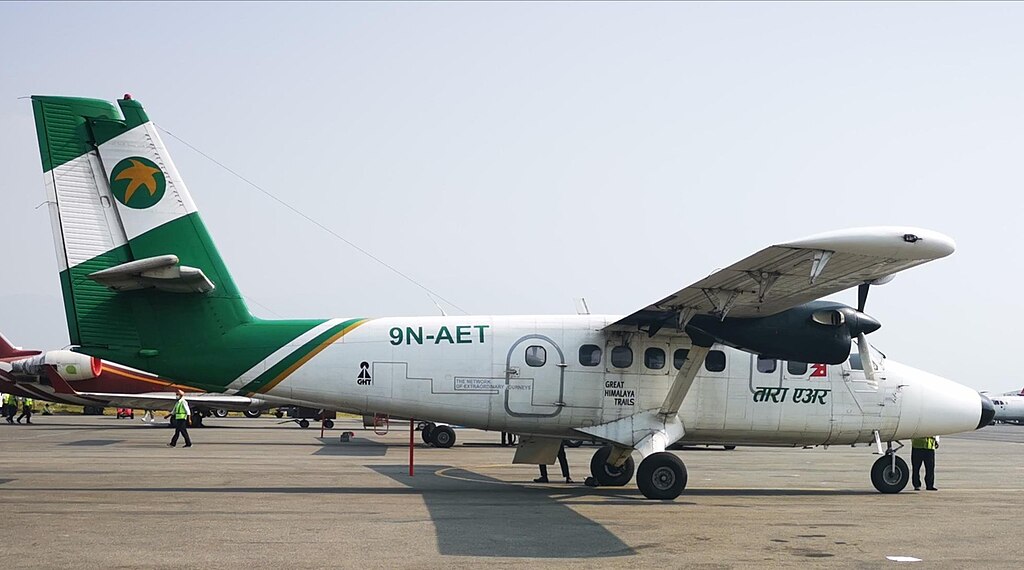
Photo:Ralf1963 |Wikimedia Commons
Tara Air connects remote and rural regions across the country. Tara Air has Viking DHC-6 Twin Otter and De Havilland Canada DHC-6 Twin Otter Aircraft in its fleet.

Tara Air DHC-6 Twin Otter 9N-AEV in Jomsom airport
Photo: Solundir| Wikimedia Commons
Details of the current fleet
| Current Aircraft type | No of Aircraft | Historic Aircraft type | No of Aircraft |
| De Havilland Canada DHC-6 Twin Otter | 1 | De Havilland Canada DHC-6 Twin Otter | 5 |
| Viking DHC-6 Twin Otter | 2 | Viking DHC-6 Twin Otter | 1 |
| Total | 3 | 6 |
Through their history, Tara Air have had a total of 9 aircraft – three of them are in use and six of them are historic.
Nepal Airlines
Nepal Airlines started as Royal Nepal Airline in July 1958. In October 1959 Royal Nepal Airlines Corporation became its sole owner. Royal Nepal started its journey with the Douglas DC-3 Dakota (28-seater). This aircraft became an icon of Nepal’s aviation history. Nepal Airlines currently operates flights in 10 different countries and 38 domestic destinations from its main hub at Tribhuvan International Airport. Royal Nepal airline carried nearly 197,000 passengers in 1970

Photo:Konstantin von Wedelstaedt | Wikimedia Commons
Nepal Airlines has operated a total of 12 aircraft in its history; only 6 are in use in the current fleet. Here are some more details of aircraft that Royal Nepal operates:
| Current fleet | No of aircraft | Historic fleet | No of aircraft |
| Airbus A320-200 | 4 | Boeing 757-200/Boeing 757-200M | 1/1 |
| De Havilland Canada DHC-6 Twin Otter | 2 | De Havilland Canada DHC-6 Twin Otter | 4 |
| Total | 6 | 6 |
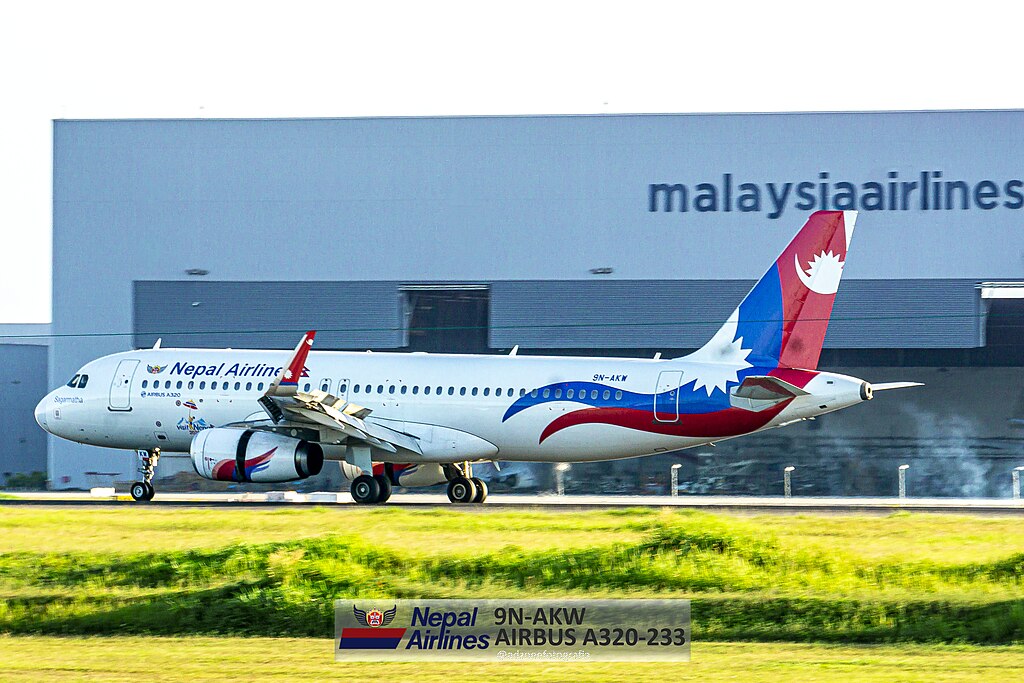
Photo: Adznee Abas| Wikimedia Commons
Let’s have a look at the historic flight of Nepal Airlines in
In 2023, Nepal Airlines rescued 250 Nepalese from Israel. Around 400 Nepalis were asked to be taken to Nepal.
Two female pilots of Nepal Airlines have conducted an international flight, for the first time in the history of the Nepal Airlines Corporation. Pilot Bhawana Pant and co-pilot Shreejana Rawat together flew the national flag carrier to Dubai from Kathmandu. Their flight will have an all-female cabin crew, it has been shared.
Accident and incident of Nepal Airlines
- On 27 July 2000, aircraft registered 9N-ABP departed Bajhang for a flight to Dhangadhi. The aircraft was found to have collided with pine trees on the 4300 feet Jarayakhali hill on the Churia mountain range, also known as Sivalik Hills, before catching fire. All the crew members and passengers died in this accident.
- On May 16th, 2013 De Havilland DHC-6-300 Twin Otter, registration 9N-ABO performing a flight from Pokhara to Jomsom (Nepal) with 19 passengers and 3 crew, landed on Jomsom’s runway 24 after the landing the aircraft suddenly changed direction and left off the runway, went down the slope to the Kaligandaki river and came to a stop on the bank with the left wing in the water. 4 passengers received serious injuries and were taken to hospitals, the other 15 passengers escaped with minor or no injuries.
Shree Airlines
Shree Airline is the second largest by fleet size, established in 1999. The airline was originally called Air Ananya and was later renamed as Shree Airlines. Shree Airline is the first private airline in Nepal to operate a fully owned fleet of five helicopters. The largest operator of Mi-17 helicopters in south-east Asia, Shree Airline is the only airline from Nepal and all of South and south-east Asia on the United Nations and World Food Program list of approved vendors.
Shree Airlines has three types of aircraft Bombardier CRJ-100 Series, Bombardier CRJ-700andDe Havilland Canada DHC-8 Dash 8, and two types of helicopters here are some no of aircraft and helicopters that are operated by Shree Airline
| Aircraft type | No of aircraft |
| Bombardier CRJ-100 Series | 2 |
| Bombardier CRJ-700 | 2 |
| De Havilland Canada DHC-8 Dash 8 | 7 |
| Total | 11 |
Number of helicopter and their type
| Helicopter type | No Of Helicopter |
| MI-17 | 6 |
| Eurocopter AS350 B3e | 4 |
| Total | 10 |
Shree Airlines operates 11 aircraft to 8 different destinations in Nepal, During the COVID-19 pandemic in Nepal, Shree Airlines carried out charter flights to Singapore, marking the airline’s international flight debut.
Accident and incident of Shree Airlines
- On 23 September 2006, a Shree Air Mil Mi-8 helicopter crashed on a chartered flight from Phungling to Ghunsa in Eastern Nepal. The accident killed all 24 passengers and crew on board, including an expedition of the World Wide Fund for Nature.
Summit Air
Summit Air started its operation in 2011 with two of its Cessna Grand Caravan, it focused its operation in STOL airfields of Nepal. Summit Air is known as Goma Air, the name was changed in 2018 from Goma Air to Summit Air. In 2014, Fishtail Air signed a deal with Goma Air to enhance Nepal’s tourism, Fishtail Air changed its name to Summit Helicopters to visualize the cooperation on 11 June 2018
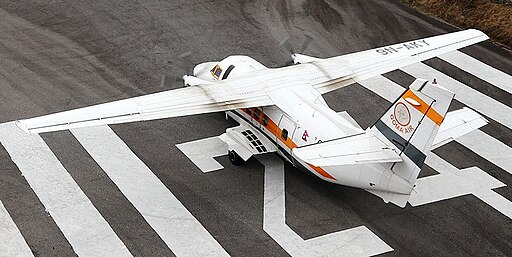
Photo: Timo Breidenstein | Wikimedia Common
Some of the incidents and accidents of Summit Air
- On 27 May 2017, a Let L-410 Turbolet registered as 9N-AKY operated by Gomm Air crashed short of the runway whilst attempting to land at Lukla airport. It was on final approach when the aircraft hit trees short of the runway and subsequently slid down a slope. The captain and the first officer died as a result of the accident, while another crew member received injuries.
- Summit Air aircraft registered as 9N-AMH, crashed at Lukla Airport on 14 April 2019. The aircraft was taking off from runway 24 when shortly after starting its run the nose was seen to dip and the plane deviated slightly to the left before the nose lifted again and the plane veers off the runway to the right onto the helicopter apron impacting two helicopters of Manang Air and Shree Air.
Summit Air offers you to different destinations in Nepal. Summit Air also offers you mountain flight from Simikot.The flight gives you a chance to embark on a mountain flight and enjoy the majestic view of Mt.Kailash, Mt.Api, and Mt.Saipal along with calm and perfectly transparent blue lakes. You can also enjoy an overview of Simikot and its different peaks.
Sita air
Sita Air got their air operators certificate in 2000 and after three years in 2003 they started their first flight with a single Dornier 228. Today the company has four Dornier DO-228 Aircraft. The airline’s main base is Tribhuvan International Airport with hubs at Pokhara Airport and Nepalgunj Airport.
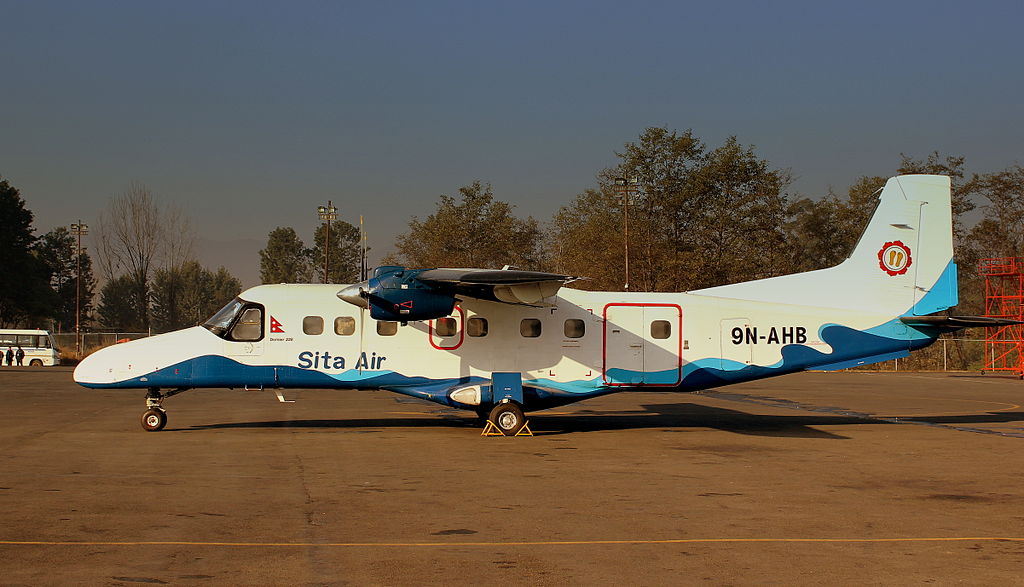
SITA AIR DORNIER 228 9N-AHB AT KATHMANDU TRIBHUVAN AIRPORT NEPAL
Photo:calflier001|Wikimedia Commons
Sita Air is mostly known for regular STOL flights to the remote mountain location of Nepal catering to visiting international tourists as well as locals. They operate 11 different domestic airports with their aircraft.
Accident and incident of Sita air
| Date | Number of casualties | Reason behind accident |
| 28 September 2012 | 19 | The flight crew did not maintain the airspeed above the stall speed and there was insufficient height available to recover when the aircraft departed controlled flight. |
| 1 June 2013, | 0 | The left hand main landing gear broke and the Dornier 228 came to rest on the side of the runway. |
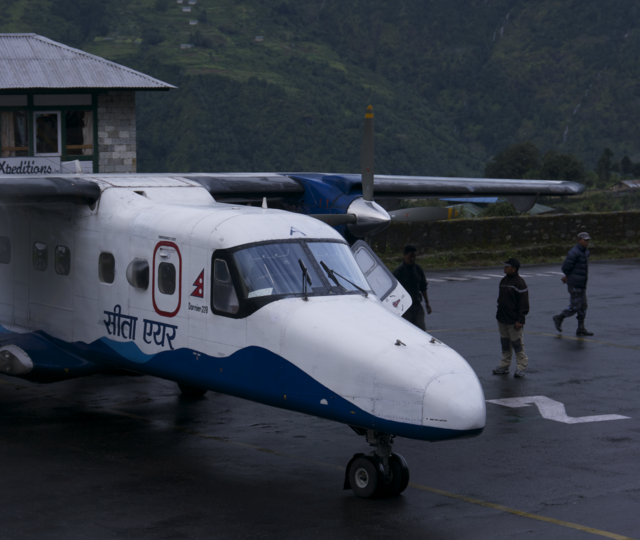
Photo:Brendan Hickey| Wikimedia Commons
Here are some ups and downs of the Sita air
- In 2014 the CAAN barred the airline from carrying passengers due to safety concerns and failing to meet international standards, and only allowed to continue operating cargo flights.
- In 2016, the airline was allowed to operate passenger services again.
- In 2017, Sita Air bought two more Dornier 228 aircraft from Simrik Airlines.
Saurya Airlines
Saurya Airlines started their fleet with Bombardier CRJ-200, on 18 August 2014, Saurya Airlines was the first airline to operate the Canadair Regional Jet in Nepal. Saurya Airlines was constrained to operate charter flights as per the regulations of the Civil Aviation Authority of Nepal after the company failed to meet the minimum required number of aircraft needed to operate as a scheduled passenger carrier.
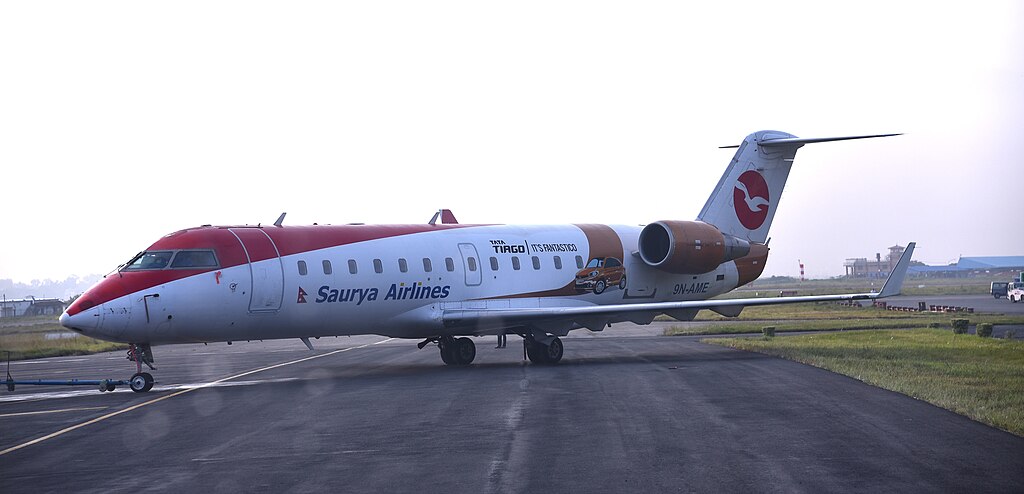
Photo:shankar s.|Wikimedia Commons
Saurya Airline has a total of three aircraft in its fleet all of them are Bombardier CRJ-200s here are some details of the aircraft.
| Aircraft type | Engine | Registered No | Status |
| BombardierCRJ-200 | 2x GE | 9N-ANM | In use |
| BombardierCRJ-200 | 2x GE | 9N-ALE | Stored |
| BombardierCRJ-200 | 2x GE | 9N-AME | Written off |

Photo:Anurup Pathak| Wikimedia Commons
In 2018, the aircraft was grounded by Tribhuvan International Airport because the airline owed 30 million Nepali rupees for the service charge of the airport. In the same year, the airline was sold to a group of Non-Resident Nepalis after air again the ownership changed and the airline became owned by the Indian Kuber group.
Here are some accidents of Saurya Airlines:
- On 24 July 2024, the aircraft 9N-AME crashed shortly after take-off from Kathmandu’s Tribhuvan International Airport, killing 18 out of 19 people on board.
All in all
The aviation industry of Nepal has both challenges and opportunities. This sector has a rich history and growth potential. The unpredictable weather conditions and the complexities of operating in high-risk airports like Lukla further complicate the landscape for airlines. Despite these challenges, carriers such as Buddha Air and Yeti Airlines, and the others we have mentioned here have demonstrated resilience and adaptability, striving to provide safe and reliable services. Issues like corruption and infrastructure development will be crucial as Nepal aims to strengthen its tourism and connectivity. With collaborative efforts from the government and private sector, the aviation industry can evolve into a reliable network.
